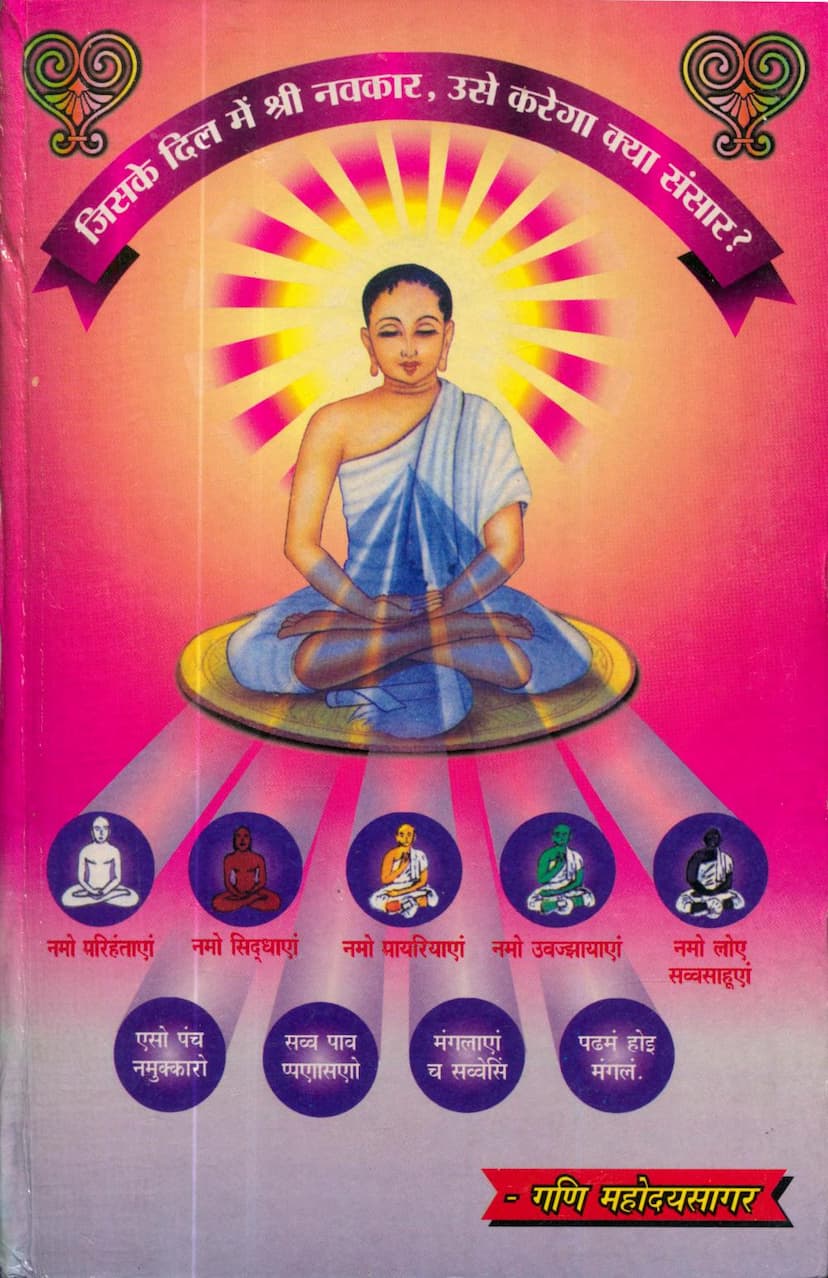Jiske Dil Me Navkar Use Karega Kya Sansar
Added to library: September 2, 2025

Summary
This document is the table of contents and introductory material for the Jain text "Jiske Dil Me Navkar, Use Karega Kya Sansar" (If the Navkar Mantra is in the Heart, What Can the World Do to Him?). The book is a compilation of modern-day miraculous accounts related to the Navkar Mahamantra, compiled by Ganivarya Shri Mahodayasagarji M.S. and published by Shri Kastur Prakashan Trust.
Here's a breakdown of the key information presented:
Book Title: Jiske Dil Me Navkar, Use Karega Kya Sansar? (Title translates to: If the Navkar Mantra is in the Heart, What Can the World Do to Him?)
Author/Compiler: Ganivarya Shri Mahodayasagarji M.S.
Publisher: Shri Kastur Prakashan Trust, Mumbai.
Key Themes and Content:
- The Navkar Mahamantra: The book is dedicated to the exploration and glorification of the Navkar Mahamantra, a central and powerful mantra in Jainism, which is a salutation to the five supreme beings (Arihants, Siddhas, Acharyas, Upadhyayas, and Sadhus).
- Miraculous Accounts (Drishtants): The primary focus of the book is a collection of contemporary, real-life incidents and stories (drishtants) that illustrate the miraculous power and protective influence of the Navkar Mahamantra. These stories aim to demonstrate how deep faith and devotion to the Navkar Mahamantra can overcome obstacles, heal diseases, provide protection, bring about positive transformations, and even lead to spiritual progress.
- Purpose: The book aims to instill and strengthen faith in the Navkar Mahamantra among its readers, encouraging them to regularly practice its recitation and experience its benefits. It seeks to show that by keeping the Navkar Mahamantra in one's heart, the trials and tribulations of the world lose their power.
- Structure: The initial pages include:
- The Navkar Mantra itself: Presented in its Jain script and transliterated.
- Foreword (Sampadakiya Prastavana): Likely by the editor, explaining the inspiration and purpose behind compiling these accounts. It highlights that the intention is to showcase the "Arvachin Adbhut Drishtant" (modern miraculous examples) to foster devotion and faith.
- Publisher's Note (Prakashkiya): Mentioning the establishment of the Kastur Prakashan Trust and the popularity of the book, which has seen multiple reprints in Gujarati, English, and now Hindi.
- Acknowledgements (Rin Sweekar/Sadar Samarpan): Expressing gratitude to the spiritual guides, contributors, donors, and supporters who made the publication possible. This section often details the lineage of spiritual teachers and acknowledges their blessings and guidance.
- Introduction to Nakoda Tirth: A brief description of the famous Jain pilgrimage site, Nakoda Tirth, which is often associated with miraculous events and devotion.
- List of Contributors and Donors: Indicating the widespread support for the publication.
- Introduction to the Compiler (Ganivarya Mahodayasagarji M.S.): Providing biographical information and highlighting his spiritual and scholarly background.
- Table of Contents (Anukramanika): A comprehensive list of the various anecdotes and their authors/sources, showcasing the vast range of experiences covered in the book. The table of contents reveals titles like:
- "Achintya Chintamani Navkar" (The Inconceivable Wish-Fulfilling Gem Navkar)
- "Vair Visarjak, Maitri Sarjak Shri Navkar" (The Navkar that Dissolves Enmity and Creates Friendship)
- "Remolvolver Jab Khilona Banta Hai" (When the Revolver Becomes a Toy)
- "Jahan Aushadhiya Harti Hain, Wahan Astha Vijayee Banti Hai" (Where Medicines Fail, Faith Becomes Victorious)
- "Cancer Kansel Ho Gaya" (Cancer Was Cancelled)
- "Maut Mar Gayi" (Death Died)
- "Bhoot Ka Bhay Dur Hua" (Fear of Ghosts Vanished)
- "Mera Navkar Mera Mitra Hai" (Navkar is My Friend)
- and many more, all pointing towards the protective, healing, and transformative powers of the Navkar Mahamantra.
Overall Message:
The book aims to serve as a testament to the profound spiritual and practical efficacy of the Navkar Mahamantra, presented through relatable, modern-day stories. It emphasizes that with sincere faith and consistent recitation of the Navkar Mahamantra, individuals can overcome worldly difficulties and spiritual obstacles, ultimately finding peace, protection, and a path towards self-realization or liberation (moksha). The title itself poses a rhetorical question, implying that if the Navkar Mahamantra resides in one's heart, the mundane world, with its suffering and challenges, loses its grip.